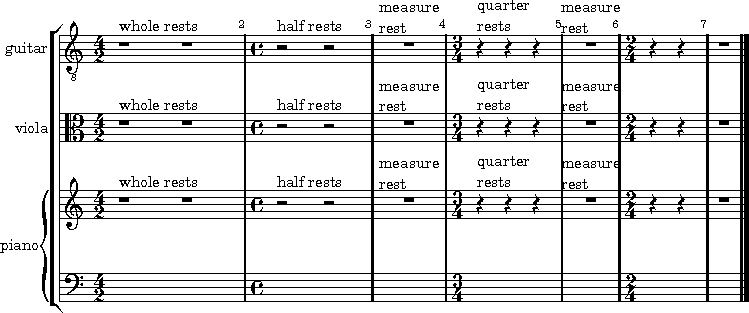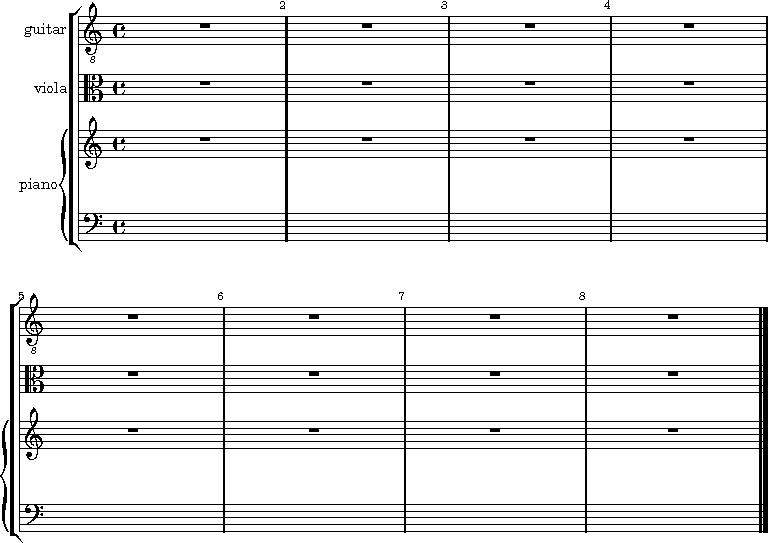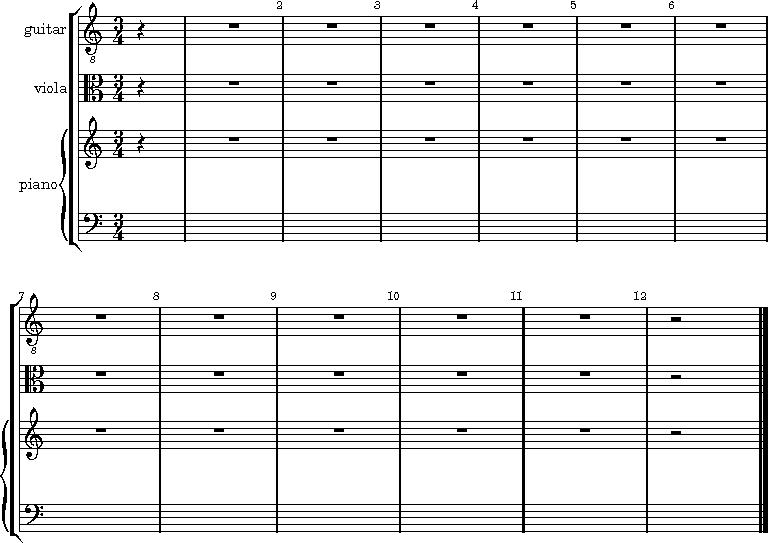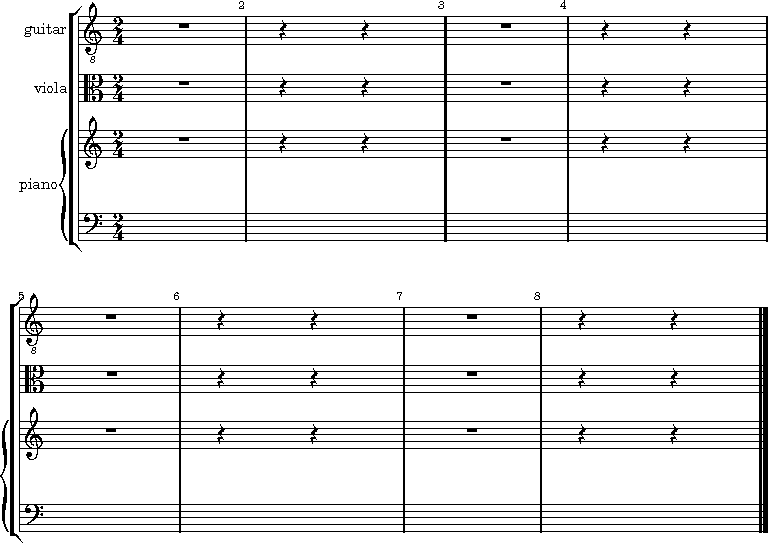Theory Project 2: Preparing Scores
David Raleigh Arnold
Estimated Time to Complete?
I would appreciate some feedback on that. ☺
Guidelines
Printing
Drawing
Use a pencil and a decent eraser. Hand written scores are lighter than printed scores, even when inked. Don’t fill in any thick lines.
System or Staff Bracket: 𝄕 Staff Brace: 𝄔
Substitute a right or left bracket resembling a staff bracket for every thick vertical line, facing in the appropriate direction. The angled lines are curved and they close the gap between the verticals, but your style is your own. The brackets may be all the same, except for their length, whether you are drawing an alto clef, a staff bracket, a double bar, or a repeat sign.
In writing music with pencil most opportunities to shorten strokes are taken, and there are no blobs except for black note heads and augmentation dots.
fig. 1.
_/ \__/ \__ __/ \__ _ _/ _/ || <--start || end--> || || <--start || _| || || middle--> || double || ||• end--> •|| _|_ ||/ || double || bar || ||• (repeat •|| _ \ ||\ || bars || || || signs) || _ alto|| \ / \ / \ / clef \
An Example Score

The Staff or Stave
A staff or stave is a line of music consisting in five staff lines. It is usually clear whether a staff line, or a whole staff, or a whole system is meant by “line” but...
The first items placed on the staff lines at the left are called clefs. From the bottom, there is a bass or F clef, a treble or G clef, an alto or C clef, and a G ottava bassa clef (G/8).
The Grandstaff
The grand staff is the system of staves used for keyboard
instruments, lute, and carillon. (There never was a
single eleven
line staff called a grand staff.) It is simply a bass
clef underneath a treble clef. There is a brace to show
that both staves are for a single instrument. Middle C is the note
midway between the staves, which is why it is called middle
The System
A system is a group of staves, grouped by having at least one line, but usually all of the bars and barlike objects, extending from the top of the top staff to the bottom of the bottom staff. You might also call a system a staff group, but all the staves and staff groups which are played together are a system.
To draw a system, first close the ends of the staves with a line from the top line of the top staff to the bottom line of the bottom staff. Indent by all means. Then draw the staff bracket to the left. Then draw the brace. Put in any instrument names you like. Bracketing the systems will help you follow the music more easily. Skip a line between systems if there is room on the paper.
When there are many staves, the instrument names are at the head of every staff in abbreviated form. Here they would be pno, vla, and gtr.
To end a system with a double bar, first close the ends of the staves with a right bracket and then draw the parallel line close to it on the left from top to bottom.
Notice that the bass staff above has nothing in it. A mistake? No, there is only one voice for each instrument. One voice means one staff.
The Score
Of course the score is the whole thing, but it can also mean a single system, as in “a line of score”, or the “top line of each score.”
The Clefs
Draw the bass or F clef.
On the bottom we have the clef with the lowest notes. It is a letter F. The blobs on the ends of the arms have gradually become dots above and below the F line and the arms have disappeared altogether. This is much easier to draw than the G clef and the line can well be drawn with a single stroke. Start where the blob is, but don’t draw the blob. Turn the dots into very short lines for better legibility. The dots indicate that the line between them is an “F”.
Draw the alto or C clef.
The two half circles on the right side of the printed clef above are both letter C’s, with the top one backwards and the lower upside down. That’s not the way to do it by hand. With the first stroke, draw a staff bracket with the corners at the top line and the middle line, and then another identical bracket from the middle line to the bottom line, so that the left sides form a continuous line. Then cross the middle arms with a vertical line. See the right end of fig. 1.
The C clef was the original clef sign, but today its use is restricted to a few instruments. It is not going to disappear any time soon, though. The alto clef indicates that its middle line is C. It is sometimes placed on other lines of the staff. For example, if it is on the line above it is called the tenor clef.
The C clef was the original clef sign, but today its use is restricted to a few instruments except for performing ancient music. It is not going to disappear any time soon. The alto clef indicates that its middle line is C. It is sometimes placed on other lines of the staff. For example, if a C clef is on the line above the middle it is called a tenor clef.
Draw the G or treble clef.
I recommend two strokes to draw the G clef.
The G clef is a small letter G, not a capital. Cover the top loop and you can see that it ia a “g” with a point at the top in an old handwriting style related to blackletter. Begin drawing it at the top of the loop, and draw the line downward to the left turning somewhat to the right and then left again, something like an elongated S. You do not need a blob on the end of that line, but if you do not have any curvature to the left at all the letter becomes a “q” instead of a “g”.
Begin at the top again from the same point and draw the other line. You don’t need a blob on the end. It is neither necessary nor desirable to mimic the printed symbol to an extreme, and in some cases a more old fashioned style is better and more current for handwritten music.
Start at the top again with the other line, and complete the “g” clef by rounding the line below the middle line of the staff, which is a “g”. The line need not curl at the end as in the printed example, but this line should at least cross the other a third time before ending.
You may like a clef you see elsewhere better, but do not do the clef with one stroke, rounding the loop at the top. Two strokes will give a much better result with speed.
If you are really hopeless as an artist, there are many bad alternatives to avoid. If you must, simply draw a small “g” with the closed part of the letter circling the line below the middle line. It’s not pretty, but it’s not wrong either.
Draw the G ottava bassa clef.
To make the clef an ottava bassa (G/8) all you need is the little “8” underneath. The guitar has has always been played an octave (eight notes) lower than written. Music is commonly written for tenors using the G clef at the octave also. Music for the piccolo (piccolo flute) is played an octave higher than written, and a little “8” at the top of the G clef indicates ottava alta (G\8). Regardless of the antiquity of the instrument and how well established the custom may be, there is no good reason at all to omit the “8” if the music is meant to be changed (transposed) by moving the notes up or down an octave.
Draw the time signature.
The time signature indicates 4/4 time. The abbreviation looks like the letter C but historically it is a half circle. It goes on the first system but not after that, unless the time changes.
Practice drawing the clefs separately on staff lines until they come a bit easier.
The Rests
There are three types of written notes: typical notes, grace notes, and rests. A rest has a time value and no sound at all. As long as there is only one voice written on the staff, each rest is placed near the middle line of the staff in a particular way.
Measure 1.
In the first measure above, in 4/2 time, there are four counts, and a half rest gets one count. Therefore, a rest gets two counts, so there are two whole rests in the measure. The whole rests are not centered. They are on the under side of the line above the middle, and when you draw them make sure they extend to only halfway between the line above the middle and the middle line.
Measure 2.
In measure 2 there are two half rests. They are not centered, and they lie like hats on the middle line, extending only halfway to the line above the middle. If you were to write a whole rest atop a half rest, there would be no space between them but neither would they overlap. You would have written the breve rest or double whole note rest from which the other two were derived. The top half of the breve rest became the whole rest and the bottom half became the half rest.
The typesetting
Measure 3.
In measure 3 there is a measure rest, or whole measure rest so called because it fills the measure completely. A measure rest is drawn as a whole rest and it is always centered in the measure.
Measure 4.
Measure 4 has three beats since it is in 3/4 time.
To draw the quarter rest, draw the right side of a letter “R”, omitting the vertical, or start with a number “2”, but pull the horizontal line down on the right. Put the hook on the bottom and it’s done. The quarter rest is a letter “R” suitable for being placed next to a letter with a vertical right side. It’s right out of Gutenberg’s Bible. The hook on the bottom is merely embellishment.
The “classical” quarter rest is a mirror-reversed 8th rest. Don’t use it.
Some people draw a version of the “S” rest which was introduced in the very early 1800’s to replace the “classical” rest. The “S” rest is like an S or backwards “Z” with the top and bottom concave instead of convex or straight. Another way to draw it is to make a line down and curving left, straight to the right, and then curving left and down. That is the easiest way to start, and I recommend it to you. If you rotate that clockwise you have an “S” rest. Or copy the eighth doubled and backwards. Or chop away half of both curves of a Gutenberg rest.
There is a lot of variation to be found in the quarter rest. The problem with the Gutenberg rest is that it takes too much vertical space and therefore collides with other rests or notes too often. For handwriting music, the Gutenberg rest and the classical rest are the worst, in my opinion.
In any case, there should be no blobs.
Measure 5.
Measure 5 still has 3 counts, but it has a measure rest and it is centered. The whole note symbol is used for the whole measure rest no matter how few counts are in the measure.
Measure 6.
Measure 6 has two counts, and measure 7 has a whole measure rest again. This time the measure rest gets only two beats. The measure rest is always centered.
A Score of Two Systems in 4/4 Time

Draw the skeleton.
Indent and draw the vertical line from the top of the system to the bottom, the system bracket, the grandstaff brace, the clefs, and the time signature.
Divide the first system with vertical lines, called bars, so that there are four measures with equal white in each in each system. The score ends with a bar closing the end, which is a single line exactly like the other bars.
If you have more than eight staves per page, skip a line between systems. The second system begins the same way except that there is no time signature. The second system ends with a bracket closing the ends of the lines and a bar on the lines a bit to the left of that, making a double bar. After drawing the ending double bar, divide the second system into four measures with equal white in each.
You don’t usually draw bars before the contents of the previous measure, but assume that there are other staves with content which requires this sort of spacing. You will seldom have occasion to draw whole measure rests first. On what would you center them?
Numbering the Measures
The first score starts with a complete measure of four beats, so the first bar is not drawn. Over the bar after the first empty measure space, place a very small “2”. Number all of the rest of the bars in that fashion. The bar which ends a system is numbered at the beginning of the next system so that it will be before the measure which is being numbered.
That is necessarily somewhat confusing. You wish to number the measures, yet you have no other option but to number the bars instead, because the measures are seen only by means of the bars which precede them.
Draw the whole measure rests
Place a whole rest in the space above the middle line, centered in each measure. These are whole rests because of their time value but whole measure rests because they fully occupy a measure. Best practice is that whole measure rests should always be centered in the measure. Other voices, especially if they are on the same staff, do not line up vertically. This practice can help to reduce crowding on the first beat at the beginning of the measure.
Practice Drawing Clefs
You want to be able to draw clefs quickly, easily, and legibly. Of course from now on you write one staff group at a time. Numbering measures is a very good idea if you are copying or arranging something. The manner of doing it is totally standard. No one does it differently.
When you can draw the exercise pretty, on to the next!
A Score in Three Quarter Time

The bar numbering is different from before because you begin numbering with the first complete measure. The quarter rest which begins the piece is not three counts, so the first measure is the measure following it. The whole measure rest in this case gets three counts, and it is centered in the measure. A whole rest is used, in spite of the measure being three counts. The practice of writing the whole rest in 3/4 time is completely dependent on the centering of the whole measure rest. Nothing with an augmentation dot is ever centered.
Starting with an incomplete measure, called a pickup or anacrusis, does not oblige one to end with another unless there is a repeat.
Again, when you can draw it pretty, next!
A score in 2/4 time

Center the whole measure rests. They get two counts.
A Problem
You never number the first measure. What if you have a line break within a measure? What is numbered? You number the first bar in the line, the measure after the measure the line breaks in. It should not matter if that number is before the clef, but that usage, though correct, can confuse players. Not you though, I hope.
End Notes:
§1 For exhaustive treatment of these subjects the Dolmetsch Music Theory site is great, in color.
§2 LilyPond is the music typesetting program which is used here. [ reference ]
[Home] [Up]